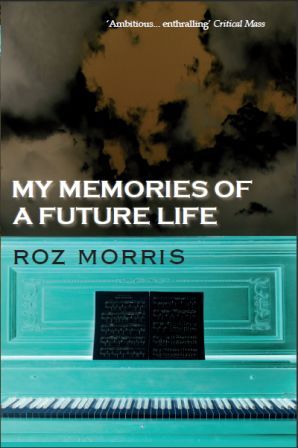I recently had an email from a friend who has a literature PhD. He had read My Memories of a Future Life and wrote me a long, detailed response. Eleven pages, actually, which was quite daunting to open. Somewhat nervously, I read it. I needn’t have worried. It was kind and appreciative.
Indeed, it seemed to give me credit for a number of clever effects that were mainly accidental, not deliberate as he seems to have imagined. 
For instance, my decision to give Gene Winter a leather bomber jacket. My faithful chronicler unpicked this as ‘bombing, linked to war – a sign that he will be destructive character’.
My actual reasons for Gene’s outfit were far more practical. I needed him to appear hunched, as if he was keeping the world out. A bomber jacket gives that postural shape in the reader’s mind. I could have left the kind of leather jacket vague, but then it might have suggested a scruffy biker. A different kind of bearing. So Gene wore a bomber jacket.
My friend also observed that Andreq, Carol’s incarnation in the future, is like a geisha. Once he’d drawn that parallel, he found more layers, exploring how geisha inhabit a separate reality, as Andreq does, and Carol has a different reality when she performs, and ‘recreates the spiritual environment that a piece of music represents, just as would a geisha with her client’.
Again, this seemed to give me credit for a lot more calculation than I actually did. When I wrote, I had much simpler aims. I was thinking only of the resonances between my two characters, Carol and Andreq. Though I’m very relieved that this aspect of the book made wider cultural sense.
Reading this essay, I was seeing the book in a new register. There are writers’ reasons and then there are the reasons readers find. Are they necessarily in tune?
I posted about this on Facebook and a merry discussion ensued. Some were reminded of school essays where they’d had to dissect texts for hidden meanings, which they were sure the author hadn’t consciously planted. This is just a fireplace. Anything else you can see is your own problem.

Of course, this is not to say we don’t take care when we write. Every word, image and phrase in My Memories of a Future Life was deliberately placed – but for reasons that were more to do with plausibility and nuance. My priority was controlling the reader’s emotional experience. With Gene’s jacket I was trying not to give a wrong impression, but in my friend’s essay it became a standout signal of its own.
That doesn’t mean I dismiss my friend’s analysis – not in the slightest. His version of the book is just as valid as mine. I wonder if he’d be disappointed to know how those creative decisions were made – that some of the effects he appreciated seem to me to be lucky accidents.
Fundamentally, I think this is a difference between writers and certain kinds of reader. I’m sure many writers are working more on gut than on grey cells.
This recent post at the Literary Hub rounded up a clutch of authors who didn’t have a formal writing education. They learned principally from reading and from life. It wasn’t study; it was an emotional process, a state of eternal noticing, a response as natural as breathing.
 One of those writers, Ray Bradbury, I featured in my Guardian masterclass on self-editing. I took the beginning of Fahrenheit 451 and used my beat sheet method to study its structure. I found contrasts and balances that I hadn’t been aware of, subtle ways in which Bradbury plays with our expectations that add to the book’s enthralling effect. The book is itself a masterclass in pacing, balance and contrast (I’ve talked about that here) . In reality, I suspect Bradbury did most of it by instinct rather than by conscious design, but if you put the book through that process, it’s there.
One of those writers, Ray Bradbury, I featured in my Guardian masterclass on self-editing. I took the beginning of Fahrenheit 451 and used my beat sheet method to study its structure. I found contrasts and balances that I hadn’t been aware of, subtle ways in which Bradbury plays with our expectations that add to the book’s enthralling effect. The book is itself a masterclass in pacing, balance and contrast (I’ve talked about that here) . In reality, I suspect Bradbury did most of it by instinct rather than by conscious design, but if you put the book through that process, it’s there.
 I’ve written before about what creative writing teachers teach. Mostly we direct a sensitivity that is already innate, and awaken the blind areas. The other side of the coin – the learning – is about building habits: first consciously, then so that they become second nature (I’ve written about that here – the three ages of becoming a writer). An example: at first you might have to be told to prefigure a major reversal; after a while, it’s something you knit into the story by gut feeling.
I’ve written before about what creative writing teachers teach. Mostly we direct a sensitivity that is already innate, and awaken the blind areas. The other side of the coin – the learning – is about building habits: first consciously, then so that they become second nature (I’ve written about that here – the three ages of becoming a writer). An example: at first you might have to be told to prefigure a major reversal; after a while, it’s something you knit into the story by gut feeling.
Earlier in this post I talked about ‘controlling the reader’s experience’. You might have laughed in a hollow way because I seem to be proving precisely the opposite. We hope we’re directing the reader to notice the things we want, but actually they scoot off into the text like gerbils and chew random things.
In the end, readers bring themselves to a book. One friend drew a parallel with his work in IT – he said you never knew how a piece of software would work until the users told you. I suppose that’s what we’re doing. Our ‘product’ isn’t even a tangible thing like a theatre production or a picture or a sofa. It’s squiggles on a page or a screen that perform a transforming effect on the reader’s mind and emotions. A novel is code, and we can’t even definitively tell you how we assemble it or how it works.
So I guess that makes it magic too. Do give me your thoughts.
 More about the beat sheet? You can find it in Nail Your Novel: Why Writers Abandon Books & How You Can Draft, Fix & Finish With Confidence.
More about the beat sheet? You can find it in Nail Your Novel: Why Writers Abandon Books & How You Can Draft, Fix & Finish With Confidence.
Thanks for the chicken pic Christian Bortes on Flickr and thanks Cat Muir for the dancing fireplace.
Oh and this little thing is less than a month to lift-off. Rather excited. Here’s my latest newsletter if you want to catch up, including a free preview.



 First published at For Books’ Sake, October 2011
First published at For Books’ Sake, October 2011 Pizarro is drawn to the dignified, aloof creature. Atahuallpa has absolute belief in his nature as a god, putting to shame the Catholic priests who are hypocritical, brutal and self-serving. The Inca king is almost Pizarro’s twin in circumstance. He was illegitimate and killed his own brother in order to take the kingdom. Self-made and brave, he is, in short, Pizarro himself – but complete.
Pizarro is drawn to the dignified, aloof creature. Atahuallpa has absolute belief in his nature as a god, putting to shame the Catholic priests who are hypocritical, brutal and self-serving. The Inca king is almost Pizarro’s twin in circumstance. He was illegitimate and killed his own brother in order to take the kingdom. Self-made and brave, he is, in short, Pizarro himself – but complete. And Antonio Salieri in Amadeus has dedicated himself to composing music. Along comes Mozart – uncouth, rude and effortlessly gifted – and much better at being alive. True to Shaffer form, Salieri destroys him.
And Antonio Salieri in Amadeus has dedicated himself to composing music. Along comes Mozart – uncouth, rude and effortlessly gifted – and much better at being alive. True to Shaffer form, Salieri destroys him.














